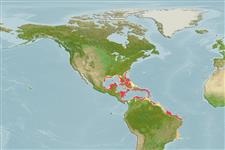Common names from other countries
Environment: milieu / climate zone / depth range / distribution range
Ecología
; rango de profundidad 0 - 88 m (Ref. 83435). Tropical; 34°N - 21°S, 97°W - 29°E
Distribución
Países | Áreas FAO | Ecosistemas | Ocurrencias, apariciones | Introducciones
Eastern Central Pacific and Western Atlantic: North America.
Length at first maturity / Tamaño / Peso / Age
Maturity: Lm ? range ? - ? cm Max length : 3.4 cm NG macho / no sexado; (Ref. 83435)
This species is found in supra-, sub-, and intertidal coral reefs, reef lagoons, and cienaga facies, particularly on algae, boulder, coral, mud, sand, rock, seagrass and shell habitats (Ref. 83934).
Life cycle and mating behavior
Madurez | Reproducción | Puesta | Huevos | Fecundidad | Larva
Members of the order Neotaenioglossa are mostly gonochoric and broadcast spawners. Life cycle: Embryos develop into planktonic trocophore larvae and later into juvenile veligers before becoming fully grown adults.
Bright, T.J. 2010. (Ref. 85586)
IUCN Red List Status (Ref. 130435)
CITES status (Ref. 108899)
Not Evaluated
Not Evaluated
Human uses
| FishSource |
Herramientas
Más información
Age/Size
Crecimiento
Length-weight
Length-length
Morfología
Larva
Abundancia
Fuentes de Internet
Estimates based on models
Preferred temperature
(Ref.
115969): 23.6 - 28, mean 26.7 (based on 306 cells).
Price category
Unknown.
